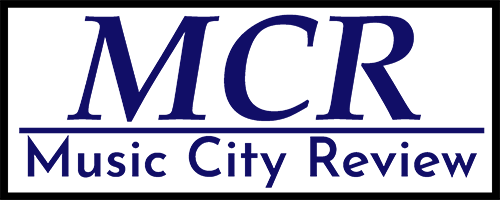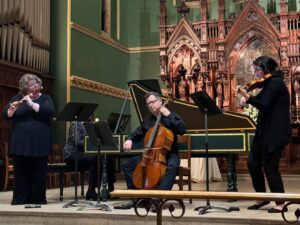The Cosmopolitan Baroque on Broadway
It was Sunday, February 2nd, to be exact, and Music City was alive with the sounds of traffic and people chatting away, making their way across streets in a rush before the pedestrian signs would change their colors, chirping like artificial birds. Christ Church Cathedral, which sits at the heart of this cacophony on Broadway, offered respite to the audience members who gathered to listen to Music City Baroque, who would transport them not only back in time but to a different continent.
I had snuck into the cathedral just in time to hear the ensemble tuning, that glorious monster of sound ricocheting off the stone walls and high ceilings, as I took a seat near the front not wanting to miss a second of the musical tour around 17-18th century Europe. As Music City Baroque, led by Artistic Director Maria Romero Ramos, began their first piece, the difference between modern instruments and those used during the Baroque became more apparent. The stringed instruments used gut strings rather than steel or synthetic materials, and the bows were shorter. The harpsichord was painted a glorious emerald green with gold accents and its strings, instead of being hit by small hammers like the piano, were plucked, giving it a brighter quality.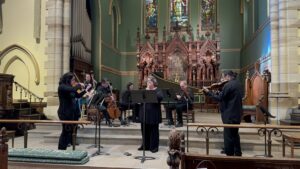
The first composer on our journey was Georg Philipp Telemann (1681-1767). As one of the most prolific composers of his day, his style included elements from all the countries he had visited. His piece Overture Suite in A minor included French, Italian, and Polish styles, though Teleman himself was German. The first movement, the ouverture, is a traditional French piece that historically heralded the king’s arrival. The dotted eighth and sixteen notes that run rampant throughout the florid ornamentation of this first movement, and the two contrasting sections, are some of the distinguishing features of French overtures. The final section, a Polish Polonaise, was in a dance-like 3/4 meter with playful, lilting rhythms taken up by the recorder, which ended the piece. Jessica Dunnavant did a shockingly prodigious job as the recorder soloist. The breath support needed to get through the long melismas accurately, almost without any break throughout the suite, is a feat that Dunnavant accomplished with what seemed to be little effort.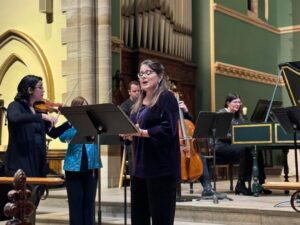
Next, we visited George Fridrich Handel (1685-1759). Although German by birth, he found success overseas in England where he spent most of his life. However, The Nine German Arias call back to Handel’s youth. Soprano Mary Wilson was taken ill and unable to perform, but luckily, Terri Richter, one of Christ Church Cathedrals’ sopranos, stepped in and saved the day. With only three days’ notice, she did an impressive job preparing two of Handel’s Nine German Arias. Meine Seele Horte is a fast-paced upbeat piece with melismas, fun trills, and text painting galore. The trills traded back and forth between the soprano and violin imitating the birds of spring and was a delight to listen to.
I must describe our third stop by starting at its end. Pride and delight shone on the faces of our musical guides as they took their bows after a wonderfully played piece. It was heartening to see that they truly enjoyed performing it. Sonata in G minor is remarkable for several reasons. The first reason is the piece’s composer, Elisabeth Claude Jacquet de la Guerre (1665-1729). Born into a musical family, her father a harpsichord builder and organist, was her first teacher. Her father must have been a successful teacher because Guerre was a child prodigy. She performed for King Louis XIV and made such an impression that she was granted a place in court under the tutelage of Madame de Montespan. She was one of King Louis XIV’s court musicians and was able to publish most of her music. In the Sonata in G minor, the contrasting moods of the movements and the continuously trading melody between instruments not to mention the virtuosic cello solo at its end made the piece well worth listening to; featuring not only French but Italian style rhythms.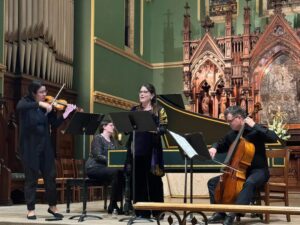
Johann Sebastian Bach (1685-1750) one of the Baroque era’s most famous composers was the last stop on our journey. Cantata BWV 51, Jauchzet Gott in Allen Landen translates to “praise God in all the land” and includes some of the most foreign elements Bach used in his works. With instrumentation consisting of soprano, natural trumpet, and strings, it is reminiscent of Italian cantatas in its structure. The cantata is separated into five movements: An aria, recitativo, aria, choral, and aria. Throughout the cantata, Bach never ceases to impress with his masterful text painting. The first lines “Jauchzet Gott in Allen Landen” ascend to the heavens with a virtuosic soprano line whose melody is continued by the trumpet. The natural trumpet was a much larger instrument than the modern version and did not have valves, but rather finger holes, similar to that of a recorder, and plays notes along the harmonic series. The sound is mellow, with a lightness that is hard to find in the modern equivalent. I cannot say enough about both soloists, but the artistry and dynamic control that Kathryn Adduci displayed were impeccable. Even as she began the piece, accompanied by strings, heralding in a tune reminiscent of a royal fanfare, I was taken by the subtle attention to detail she played with. This piece is virtuosic and highlights both soloists. I cannot say enough for Kathryn Adduci and Terri Richter.
As the concert ended and we all returned from our trip through 17-18th century Europe, I was struck by the passion every musician on stage had played with. The emotion and openness with which they played, and the educational opportunity they continue to provide as the only period ensemble in Nashville ensured that I will be looking forward to their next concert with anticipation.
